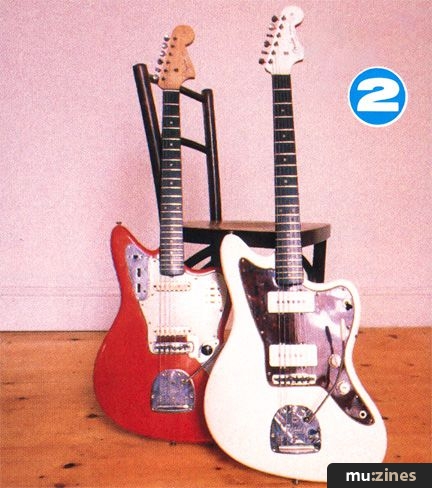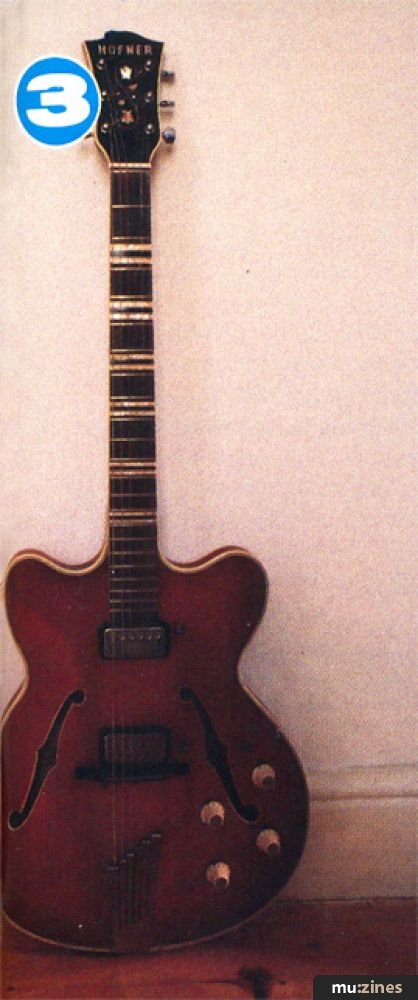Magazine Archive
Home -> Magazines -> Issues -> Articles in this issue -> View
The Famous Five | |
GuitarchivesArticle from International Musician & Recording World, July 1986 | |
Five aging axes exhumed by Paul Trynka
Five go twang with the incredibly mature Paul Trynka's guide to lashings of fab guitars

1. Gretsch
Hands up all of you Ford Sierra owners. Okay, if you don't boast of owning a motor beloved of bathroom furniture salesmen and insurance reps, why stick to the guitar equivalent? This is a celebration of the Morris Minors of the guitar world — built to last, easy to maintain, no built-in obsolescence. You've probably noticed there's more of them about lately — plus it costs a lot these days to buy a good example. Yup, we are talking old semis and '60s surfing guitars — so here's a rundown of the top five of the indies old guitar chart.
To quote one London dealer, Gretsch guitars seem to be coming out of the woodwork lately. They're individualistic beasts, with frets like railway sleepers and eccentric pickup switching, but that's more than compensated for by their looks — on a par with Jimmy Dean haircuts and jeans with the right colour tab — plus the fact they actually sound good. This is due to a combination of the depth of a hollow body, and the bite of Filtertron pickups. These pickups are humbucking, but have narrow, shallow coils and small magnets, giving them more of a single coil sound.
The photo is of the Cult's Billy Duffy playing a late '70s White Falcon, a model also seen lately in the hands of Elvis Costello and the Edge. As a rough chronology, all early Gretsch's have single cutaways and single coil, De Armond pickups. The double coil Filtertron pickups appeared around 1958, as did 'half moon' fret markers. Most models went to double cutaways around '63, and all guitars made after 1970 have truss rod adjustment at the neck heel, and hence no truss rod cover on the headstock.
Late '50s examples of the more upmarket models like the White Falcon, Chet Atkins Hollow Body, Country Club and Gent fetch around the price of a DX7. Sixties examples will set you back the price of an Alpha Juno 2, and on all of these models you get control knobs and individual aftertouch for the price.

2. Fender
Next we come to the Fender Jazzmaster and Jaguar. Basically similar, the Jazzmaster is the one with the big square, mellow-sounding pickups, the Jaguar has smaller pickups, of unusual design, a string mute on the bridge, and a shorter scale length which gives a different feel to its predecessor. The Jazzmaster was introduced in 1957, the Jaguarin 1961, and though neither achieved the popularity of the Strat and Tele, they were just as well engineered and functional. The red guitar here belongs to Red Guitar John Rowley, who favours it for recording, although the bridge is too unstable to use throughout a live set, as it's rather worn. The tremolo arm on these creatures is truly wunnerful, with a very light touch and good tuning stability. Incidentally, if you ever wondered what the small black plastic controls are for, they consist of a sliding switch which engages the rhythm pickup, with roller knobs for volume and tone. The Jaguar has a sliding switch for each pickup, along with a bass cut switch. Apart from neck-stamp and serial numbers, both guitars may be dated by their neck features; both had dull, clay fret marker dots when introduced, which were replaced by pearl dots in 1964. The necks were bound from 1965, after the CBS takeover, with block markers after 1966.

3. Höfner
Prices of both models have shot up lately — expect to pay around £400 for an early '60s Jag, and a bit more for a Jazzmaster, if you're buying privately. If you see one in the small ads though, don't hang around. Both Tokai and Fender are rumoured to be making copies, which might be interesting.
Prices are somewhat less intimidating for the next one up. The photo is an early'60s Hofner Verithin. A wide range of Hofners was imported to Britain from the late '50s, and their popularity increased with the beat boom a few years later. Considerably cheaper than imported American guitars, they were nonetheless well made with functional hardware, much of it made by Schaller.
Early cello bodied models can be acquired quite cheaply, if you can find them — '60s semi-acoustics fetch around £150-250, which is good value, especially for the more ornate models like a bird's eye Maple topped Committee. Solid models are considerably cheaper. Hofners are still being produced today — the modern Verithin has no f-holes, and a sustain block down the middle and its quality testified by the Banshees' John Carruthers. Elsewhere in this issue is one of their new big semi-acoustics.

4. Vox
Like Hofners, Vox guitars were popular with those funny people with cuban heels and plastic Beatle wigs. There were two main lines, the trapezoid Phantom and the teardrop Mk series. Both were produced in bass and 12-string forms, with progressively more variants being produced towards the end of the '60s. The example shown here is a Phantom Special, with myriad built-in effects, including repeat, an E for tuning, and a fuzz which makes the guitar sound like grandad playing a comb and paper through a tranny radio with flat batteries. The guitar is almost hollow due to the old tagboard circuitry used, so god knows what the inside of a Vox organ guitar is like (it has 18 knobs and switches just on the outside).
The 12-string popularised by Will Sergeant on Killing Moon has been seen at Rock-star-only prices fairly recently, but most six-string models can be had for £200 or less — higher prices are due solely to pose value, rather than playability or sound.

5. Rickenbacker

Lastly, who could forget the 12-string Rickenbacker, the daddy of all 12-strings. The guitar shown here is a rare example of a Capri 12-string from around 1960. The later and more common 330-12 differs by having a slash f-hole, and R-shaped tailpiece and triangular position markers. The necks of both guitars are surprisingly small — the ingenious use of solid/slotted tuner fitting avoids an unwieldy head design. Importing of Rickenbackers into Britain has always been patchy, with several changes of distributor, and consequently 12-string models in particular don't change hands that often. Being in vogue at the moment, it's a seller's market — so what you pay is probably what you're asked. At least they're available again new now.
Like everything else, if you buy from a specialist shop you have to pay for the privilege — after all, they have to go out and find the things. Out of London you can pickup Vox's and Hofners for the price of a Taiwanese copy — an ad in the local wanted column might be worth trying.
Think positive — even if you don't have the same amount of money as Keith Richards to buy your next guitar, at least you've got the time to go looking around dusty old second-hand shops for them.
Publisher: International Musician & Recording World - Cover Publications Ltd, Northern & Shell Ltd.
The current copyright owner/s of this content may differ from the originally published copyright notice.
More details on copyright ownership...
Feature by Paul Trynka
Help Support The Things You Love
mu:zines is the result of thousands of hours of effort, and will require many thousands more going forward to reach our goals of getting all this content online.
If you value this resource, you can support this project - it really helps!
Donations for April 2024
Issues donated this month: 0
New issues that have been donated or scanned for us this month.
Funds donated this month: £7.00
All donations and support are gratefully appreciated - thank you.
Magazines Needed - Can You Help?
Do you have any of these magazine issues?
If so, and you can donate, lend or scan them to help complete our archive, please get in touch via the Contribute page - thanks!






